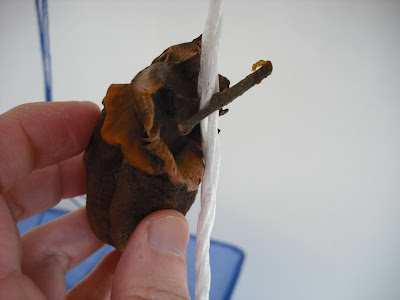I'm very sorry to say that my way of making hoshi gaki was not so good. For one thing, I put too many persimmons in the drying net, and for another, the dehumidifier was not so effective in drying the persimmons.
One week after I started drying the persimmons, I dried some of them in the traditional way.
You can view how to tie persimmons on a string here.
As you can see, if you decide to dry persimmons in the traditional way, you have to collect them from the tree in such a way that the twig is shaped like a T.
大変残念なことに、私の干し柿の作り方はあまり良くありませんでした。干し網に柿を入れ過ぎたのと、除湿機が柿を干すのにあまり効果がなかったことが原因です。
柿を干し始めてから一週間後、幾つかを伝統的な方法で干しました。
柿をひもに付ける方法はここを見て下さい。
見て分かるように、柿を伝統的な方法で干すには、小枝がTの字になるように柿を木から収穫する必要があります。
I tried one. It was sweet and tasty!
一つ食べてみました。甘くて美味しかったです。
Subscribe to:
Post Comments (Atom)



9 comments:
It looks delicious (the last photo). Is it the same net you would use for drying aji? (For salt grilled aji?).
Sissi: Yes, exactly the same one. I only have one. I want to use it for other purposes like drying enoki, daikon, and steamed sweet potatoes (to make hoshi imo (dried sweet potatoes). Maybe I should buy another one...
What happened to the persimmons in the net storage? Growing mold or yeast? Don't tell me you have to throw them away?
Picking persimmons with a t-handle would take 20 years (first I have to grow a tree...). I think drying in an electric dryer will not do concerning the taste - there must happen some time and temperature related changes in the fruits as fermentation, building up sugar content, breaking the tannine and such.
I have an idea about how to use a fishing line for hanging up the fruits but I have to try it out first.
Very interesting indeed, thanks for sharing.
Hi Hiroyuki, sorry that it didn't work out but at least it was an interesting experiment! There are Hachiya persimmons for sale in the farmers' market, but they are so expensive that I'm saving them to eat fresh. Apparently Americans aren't so fond of the astringent type persimmons so they aren't readily available. I guess I should grow a tree too ;)
Kiki: Some of the persimmons in the drying net have become only partially moldy, and I have not yet thrown them away, hoping that they are still edible.
>fermentation, building up sugar content, breaking the tannine and such.
To the best of my knowledge, none of these processes occur during persimmon drying. If fermentation occurred, the persimmons would eventually turn into vinegar.
The sugar content won't change, only the water content will be reduced, making the persimmons sweeter. Drying makes soluble tannin insoluble.
YSC: I didn't say it didn't work; it did work to some extent, but I should have put fewer persimmons in it to ensure air circulation. I won't use the net method again, but I will tie them on a string, and dry them indoors with the dehumifier on. Drying them outdoors is very risky. I learned from someone's blog that she lost all of her 500 persimmons due to a single rainfall.
One more thing: Hachiya is an astringent variety, suitable for making hoshi gaki.
Hiroyuki: According to this http://www.slowfoodusa.org/index.php/programs/ark_product_detail/japanese_massaged_dried_persimmon_hoshigaki/
they give the still drying persimmons a massage once in a while. I thought persimmmons are getting quite soft and soggy during ripening. How do they perform this?
I found quite astringent persimmons (more round shaped) at a turkish market. I could air dry them without any danger caused by rain or snow outside under my porch roof. But massage, really and how to?
First of all, massaging is preferred but not essential. My wife and son did little massaging when they made hoshi gaki for the first time:
http://hiro-shio.blogspot.com/2008/11/hoshi-gaki-dried-persimmons.html
Massaging is effective if you want to have hoshi gaki before they are completely dried (like "anpo gaki" あんぽ柿).
Massaging is, however, required to make the inner sugar appear on the surface as white powder.
For how to massage them, visit this site:
http://marron-dietrecipe.com/print/p_dessert_tsurusikaki.html
scroll down and view the 4th and 5th videos.
Dojo Hachiya Gaki 堂上蜂屋柿 are made by using a special hard brush to make many small scars on the surface of each persimmon and coat the persimmon beautifully with sugar powder.
Kiki:
Not that one but this one:
http://marron-dietrecipe.com/desert/desert_tsurushigaki.html
Post a Comment